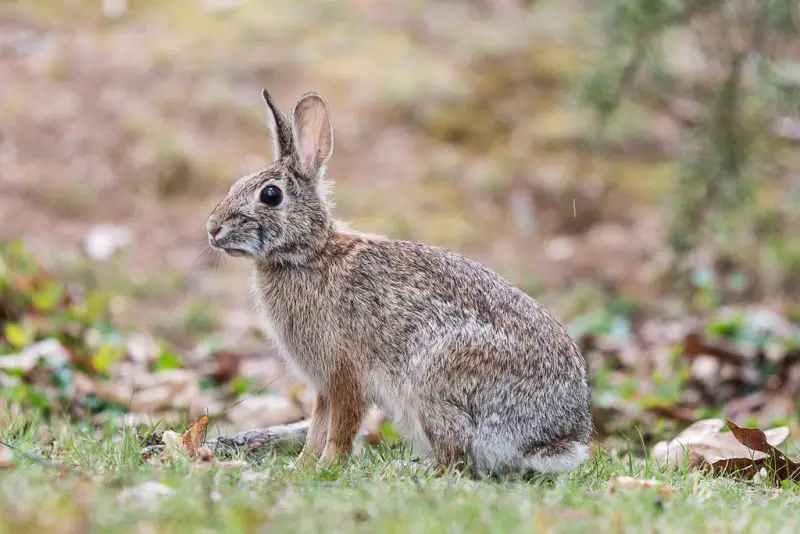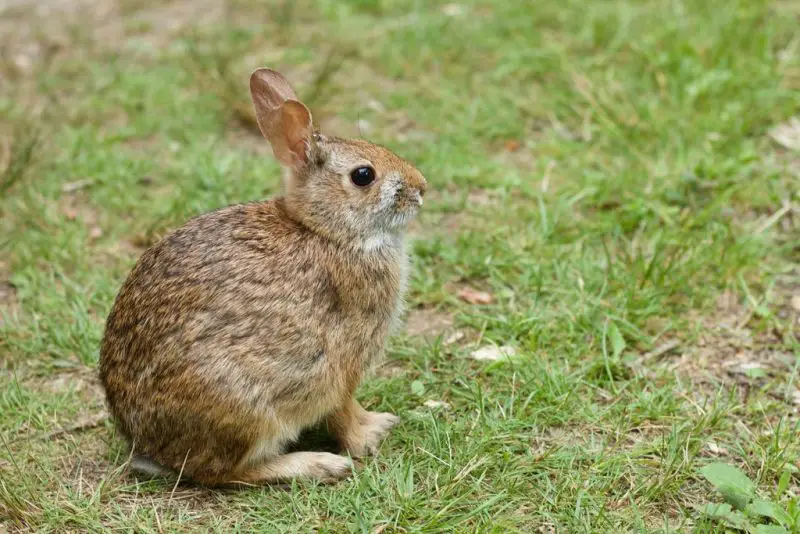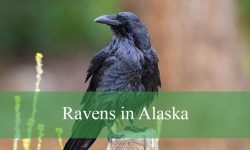Massachusetts is home to a diverse population of wild rabbits, with two main species thriving across its fields, forests, and suburban areas. The Eastern Cottontail (Sylvilagus floridanus) and the New England Cottontail (Sylvilagus transitionalis) are the state’s most common wild rabbits, each playing a vital role in local ecosystems.
These rabbits are a favorite among wildlife enthusiasts and photographers due to their elusive behaviors and unique appearances. Although they may seem similar at first glance, close observation reveals distinct differences in size, coat color, tail shape, and habitat preferences.
This guide provides a detailed look at both species, covering identification tips, physical traits, behavior, habitat, reproduction, and fun facts. A helpful comparison table is also included to make it easier to tell these two fascinating rabbits apart.
Eastern Cottontail (Sylvilagus floridanus)

Identification and Physical Characteristics
The Eastern Cottontail is the most common rabbit species in Massachusetts. Its fur is predominantly reddish-brown, interspersed with gray, giving it a warm, earthy tone that blends seamlessly into fields and meadows. A hallmark feature is the white fluffy tail, which resembles a cotton puff, earning the species its common name. The ears are long with black-tipped edges, and the eyes are large, dark, and expressive, providing excellent peripheral vision to spot predators.
Adults typically measure 16–20 inches in length and weigh 2–4 pounds. Their bodies are compact with powerful hind legs, enabling them to leap quickly to escape threats. Unlike some other mammals, Eastern Cottontails have a slightly hunched posture when at rest and tend to remain low to the ground to stay concealed. Their front paws are small but agile, used for grooming and digging shallow nests.
Behavior
Eastern Cottontails are primarily crepuscular, meaning they are most active during dawn and dusk. They are solitary outside the breeding season, and their behavior is largely driven by foraging and predator avoidance. When threatened, these rabbits rely on explosive bursts of speed, running in zigzag patterns to evade predators such as foxes, hawks, and domestic cats.
They feed mainly on grasses, clovers, and garden vegetables, occasionally nibbling on bark and twigs in winter when other food sources are limited. Eastern Cottontails are meticulous groomers, frequently cleaning their fur with their paws, which also helps reduce scent traces detectable by predators.
Habitat
Eastern Cottontails are highly adaptable and can be found in a variety of habitats. They favor open fields, meadows, brushy edges of forests, and suburban backyards. These rabbits require dense cover for nesting and hiding, often seeking refuge in tall grasses, shrubs, and hedgerows. They are also known to inhabit small wetlands and marsh edges, particularly where thick vegetation provides protection from predators.
Massachusetts’ agricultural landscapes and suburban green spaces offer ideal conditions for Eastern Cottontails. Observation is easiest in early spring and summer when vegetation is lush and provides both food and shelter.
Reproduction
The breeding season for Eastern Cottontails spans spring through late summer, with females capable of producing 3–6 litters per year. Each litter typically contains 3–8 kits. Nests are shallow depressions in tall grass or under dense shrubs, lined with the female’s fur and plant material. Kits are born blind, hairless, and entirely dependent on their mother for warmth and nutrition. Within a few weeks, the young are able to leave the nest and begin independent foraging.
Fun Facts
Eastern Cottontails can leap up to 10 feet in a single bound, a skill crucial for evading predators. They also have a unique way of marking their territory using droppings and scent glands located beneath their chins. Surprisingly, despite their frequent appearance in suburban areas, these rabbits are highly cautious and rarely approach humans closely.
New England Cottontail (Sylvilagus transitionalis)

Identification and Physical Characteristics
The New England Cottontail is slightly smaller and more elusive than the Eastern Cottontail. Its gray-brown fur provides excellent camouflage in dense thickets and brushy habitats. Unlike the Eastern Cottontail, the reddish tones are muted or absent. The tail is shorter, and the body appears more compact and less rounded. Adults typically measure 14–18 inches in length and weigh 1.5–3 pounds.
The species has smaller ears and darker-tipped fur around the eyes, making it blend seamlessly into its environment. Due to its secretive nature, New England Cottontails are much harder to spot in the wild.
Behavior
New England Cottontails are crepuscular and extremely wary of predators. Unlike the more adaptable Eastern Cottontail, they prefer dense vegetation where they can remain unseen. These rabbits are solitary and territorial, rarely venturing into open spaces. Their primary activities include foraging, grooming, and burrowing shallow forms in thick underbrush for shelter.
When threatened, they freeze initially, relying on camouflage, and then sprint in short bursts if a predator comes too close. Their diet mirrors that of the Eastern Cottontail but includes a higher proportion of woody plants and shrub bark, reflecting the habitats they occupy.
Habitat
New England Cottontails inhabit dense thickets, early successional forests, and wetlands. Habitat loss from suburban development and forest maturation has dramatically reduced their populations in Massachusetts. They require areas with dense understory vegetation to hide from predators and raise young safely. Conservation efforts focus on restoring brushy habitats and creating corridors to connect isolated populations.
Reproduction
The breeding season occurs mainly in spring and summer, with females producing 2–3 litters per year, each containing 3–5 kits. Nests are carefully hidden beneath shrubs or brush piles. Kits are born vulnerable, and survival rates are lower than those of Eastern Cottontails due to higher predation and limited suitable habitat.
Fun Facts
The New England Cottontail is considered a species of conservation concern, as it has been declining due to habitat loss. These rabbits play a vital ecological role by dispersing seeds and serving as prey for native predators like foxes, hawks, and bobcats. They are often used as indicator species for healthy brushland ecosystems.
Comparison Table: Eastern Cottontail vs New England Cottontail
Feature |
Eastern Cottontail |
New England Cottontail |
|---|---|---|
Scientific Name |
Sylvilagus floridanus |
Sylvilagus transitionalis |
Size |
16–20 in, 2–4 lbs |
14–18 in, 1.5–3 lbs |
Coat Color |
Reddish-brown with gray |
Gray-brown, less reddish |
Tail |
Prominent white “cotton” tail |
Shorter, less prominent |
Habitat |
Fields, meadows, forest edges, suburbs |
Dense thickets, early forests, wetlands |
Behavior |
Crepuscular, highly adaptable |
Crepuscular, secretive |
Litters per Year |
3–6 |
2–3 |
Kits per Litter |
3–8 |
3–5 |
Conservation Status |
Common |
Species of concern |
Observation Tips in Massachusetts
Spotting wild rabbits in Massachusetts can be challenging but rewarding. The best times to observe both species are early morning and late evening, when they are actively foraging. Eastern Cottontails are easier to see in open fields, suburban gardens, and edges of forests. New England Cottontails, however, require visits to dense brushlands, wildlife management areas, or conservation lands with thick understory.
Patience is key: moving quietly and using binoculars or spotting scopes increases the chances of a successful sighting. Always respect their habitat and maintain a safe distance to avoid stressing the animals.
Fun Facts About Massachusetts Wild Rabbits
Wild rabbits in Massachusetts have several fascinating traits. Eastern Cottontails can reach bursts of speed up to 18 mph to escape predators, showcasing their agility and alertness.
The New England Cottontail is a rarer species and is considered a conservation priority due to habitat loss and declining populations.
Both species play a crucial ecological role, serving as prey for numerous predators and aiding in the dispersal of plant seeds.
During the harsh winter months, wild rabbits rely heavily on their camouflage and limited food sources, occasionally feeding on bark and twigs to survive.
Conclusion
Wild rabbits in Massachusetts, represented by the Eastern Cottontail and New England Cottontail, are fascinating creatures with distinct characteristics and important ecological roles.
Understanding the differences between these two species helps improve wildlife observation, promote conservation awareness, and deepen appreciation for the state’s natural diversity.
Recognizing these rabbits and their habitats can enrich your experience in Massachusetts’ landscapes, whether you are a wildlife enthusiast, photographer, or conservationist.
FAQs About Wild Rabbits in Massachusetts
What types of wild rabbits live in Massachusetts?
Massachusetts is home to two main wild rabbit species: the Eastern Cottontail (Sylvilagus floridanus) and the New England Cottontail (Sylvilagus transitionalis). The Eastern Cottontail is common throughout the state, while the New England Cottontail is rarer and considered a species of conservation concern.
How can I tell Eastern Cottontails and New England Cottontails apart?
Eastern Cottontails are generally larger, with a reddish-brown coat and a prominent white tail. New England Cottontails are smaller, gray-brown, and have a shorter, less conspicuous tail. Habitat preference also differs: Eastern Cottontails are found in fields, meadows, and suburban areas, while New England Cottontails prefer dense thickets and early successional forests.
When is the best time to see wild rabbits in Massachusetts?
Wild rabbits are crepuscular, meaning they are most active at dawn and dusk. Early mornings and late evenings are the best times to observe both species in their natural habitats.
What do wild rabbits eat in Massachusetts?
Both species feed mainly on grasses, clovers, and garden plants. During winter, when vegetation is scarce, they may eat bark, twigs, and woody plants. Their diet helps them survive seasonal changes while also playing a role in seed dispersal.
How do wild rabbits reproduce?
Eastern Cottontails can have 3–6 litters per year, each with 3–8 kits. New England Cottontails have 2–3 litters per year, each with 3–5 kits. Nests are shallow depressions hidden under vegetation or shrubs, lined with fur and plant material to protect the young.
Why is the New England Cottontail considered rare?
The New England Cottontail has experienced significant habitat loss due to suburban development, forest maturation, and agricultural expansion. Conservation programs focus on restoring brushy habitats and maintaining corridors to connect isolated populations.
Are wild rabbits important to the ecosystem?
Yes. Wild rabbits serve as prey for many predators such as foxes, hawks, and bobcats. They also help disperse seeds and contribute to the health of brushlands and meadows, making them an integral part of Massachusetts’ ecosystems.






